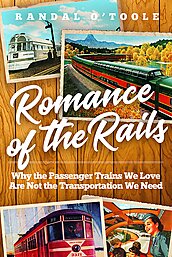Romance of the Rails is the culmination of Randal O’Toole’s lifetime of research and experience as an enthusiast of the rails and as a transportation expert. American transportation has undergone many technological revolutions: from sailing ships to steamships; canals to railroads; steam to diesel; horse-drawn to electric streetcars; passenger trains and urban rail transit to airplanes and automobiles. The government has allowed and encouraged most of these revolutions, but it spends billions of dollars a year attempting to turn back the clock for rail transit and intercity passenger trains.
To show why, O’Toole provides a detailed history of rail in America leading to the present, when federally subsidized efforts to return to rail’s golden age are doing more harm than good. O’Toole examines the costly allure of high-speed trains and light rail, demonstrating that passenger rail doesn’t even work well in Europe and Asia, much less here. Far from being backward, America’s railroads are the envy of the world, moving freight efficiently and profitably while leaving passengers to other modes of travel that are faster, less expensive, and more convenient.
The book concludes that the passenger transportation of the future will rely on America’s 4 million miles of roads and on air travel. As Romance of the Rails thoroughly chronicles, Americans love passenger trains, but given the vast resources inexplicably being poured into them, we are being taken for a ride.
